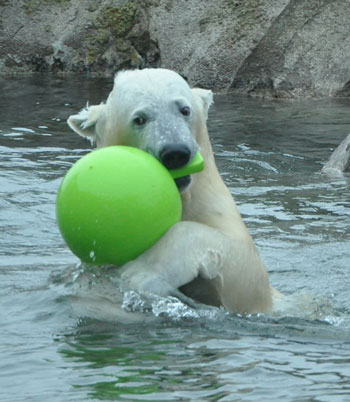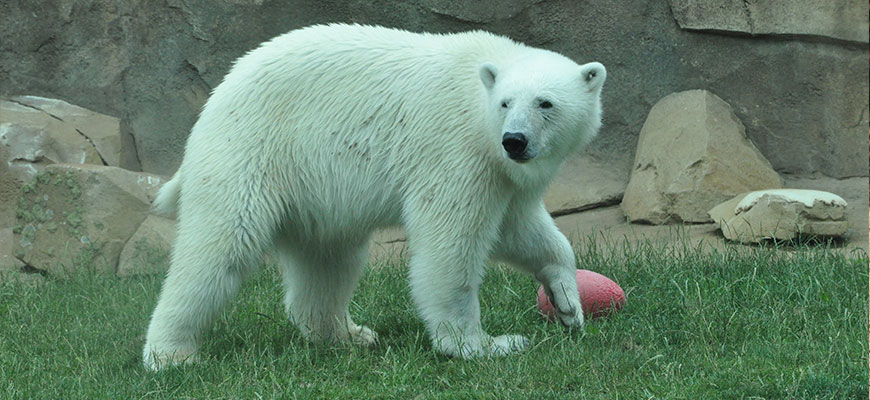By Kelly Grether, Director of Development
 Thank you for being a donor, member, friend, advocate and all-around fan of your Zoo.
Thank you for being a donor, member, friend, advocate and all-around fan of your Zoo.
Your commitment to our mission helps maintain award-winning exhibits, sustain education programs and beautify walking paths — and in doing so provides a place for families to explore, learn and create lifelong memories. Your support also allows us to provide both the everyday and the critical specialized care needed to thousands of vulnerable, threatened and endangered animals such as the rockhopper penguin and polar bear.
We wish to express our gratitude by sharing a success story with you.
Many have fallen head over heels for our polar bear “Qannik” since she arrived at the Louisville Zoo four years ago. When she landed in Glacier Run, she was approximately six months of age. Before her trip to Louisville, Qannik had made national headlines when she was found underweight on Alaska’s North Slope, separated from her mother and sibling. After several days of observation with hopes that she would reunite with her mother, the U.S. Fish and Wildlife Service (USFWS) decided to attempt a rescue operation. It’s extremely rare for animals to be removed from their native habitat like this, but the USFWS felt it was necessary to save the cub. After a brief stay at the Alaska Zoo, she headed to Louisville.
The energetic and playful Qannik that you see swimming and hiding toys in Glacier Run developed a lameness in one of her hind legs in June 2013. Keepers noticed changes in her behaviors and eating habits and Zoo Veterinary staff placed her on a medical treatment plan. When it was determined she was not healing, the decision was made to place her under anesthesia to determine the root cause of her problem.
After careful examination, she was diagnosed with a systematic life-threatening fungal infection, blastomycosis. Curator of Mammals, Jane Anne Franklin, who had worked with Qannik closely from the moment of her arrival, was the only person from whom Qannik would take medication; and she was picky about how the medication was administered. For example, she preferred medicine be given to her in spoonfuls of mayonnaise; she wasn’t interested in her usual treats. Under close watch and expert care, her health, behavior and eating habits gradually improved. Today, we’re happy to say she is free and clear of any trace of the infection and completely back to her normal self.
With fewer than 25,000 polar bears remaining in the world and the species listed as threatened since 2008, Qannik’s health is vital to the future of the polar bears. She was placed in an accredited, managed zoo system to assist with future breeding which will help to diversify and strengthen the genetic pool for her species.
Thank you for caring about your Zoo, our animals and our planet. You make it possible for us to work with scientists, conservationists, members of the medical community and Zoo colleagues all across the world to ensure that the earth and the animals that live here — like the polar bears — will thrive for generations to come.
We are extremely grateful for you.

